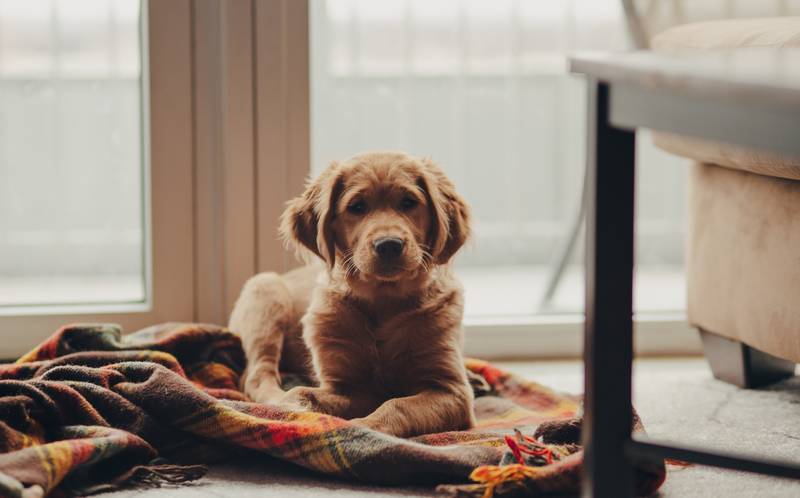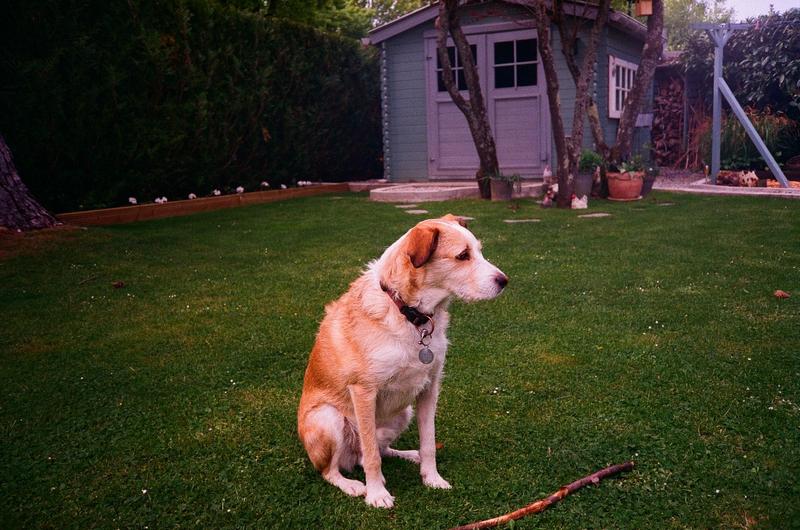“My Dog Won’t Go Potty Outside Without Me!” [5 Step Fix]
Our four-legged friends’ unconditional love and constant desire to be in our presence feels incredible, but what happens when your dog won’t go potty outside without you? Why won’t they pee or poop outside alone? And does it mean anything different when dog won’t go outside alone at night, or if the problem just started suddenly?
In this article, we’ll delve into all of the possible reasons behind this behavior and of course, teach you how to get your dog to go outside without you. Together, we’ll get you through this tricky situation, while also explaining things like whether your dog is afraid or if it’s just a case of a clingy puppy.
Keep reading below for all this and more in our article “My Dog Won’t Go Potty Outside Without Me!”
How to Get My Dog to Go Outside Without Me

Your dog may not want to go outside alone due to separation anxiety, a lack of confidence, or past negative experiences. But don’t worry, there are ways to help your furry friend become more independent. Here’s how to get your dog to stay outside alone:
- Gradually increase the distance between you and your dog when they go potty.
- Establish a consistent potty routine.
- Offer positive reinforcement and rewards.
- Make their outdoor environment comfortable and secure.
- Be patient and persistent.
Start by standing a short distance away from your dog when they go potty, and then progressively move further away during each subsequent outing. To make this process easier, you can use a long leash, allowing your dog to have some space while still feeling secure.
As your dog becomes more comfortable, you can begin using shorter leashes or even try letting them off-leash in a safe, enclosed area. This gradual approach helps your dog build confidence and become more independent, as they learn that they can successfully go potty even when you’re not directly by their side.
Be patient and consistent during this process, as it may take some time for your dog to adjust to the increased distance between you. Remember to praise and reward them for successfully going potty with increasing independence, as this positive reinforcement will encourage them to continue building their confidence.
Having a consistent potty routine is crucial in helping your dog feel comfortable going outside alone. Choose specific times each day to let your dog out and stick to this schedule. This predictability helps your dog understand what to expect and eases their anxiety.
Positive reinforcement plays a key role in encouraging your dog to go outside without you. Praise them and offer treats when they successfully go potty alone. This helps your dog associate going outside by themselves with positive outcomes.
Ensuring that your dog’s outdoor environment is comfortable and secure can also help them feel more at ease. Provide a designated potty area, shelter from the elements, and perhaps some toys to make the space inviting.
Finally, remember that patience and persistence are essential when teaching your dog new habits. It may take some time for your dog to adjust, but with consistent effort and understanding, they’ll soon learn how to enjoy their time outside alone.
These steps will get your dog to stop refusing to go potty outside without you, but it’s important to remember that the underlying behavioral issues (fear, codependence, anxiety) that were causing all of this to begin with will still be present. And until you address those, any positive changes you see are only going to be temporary.
“Okay, so how do I make them last then?”
By getting your dog to truly choose to follow your direction, that’s how. I tried many times to write out how you can do that before deciding it made more sense to just link you to the free video series that explains it better than I’d ever be able to.
The series is by a man named Dan who is one of the world’s leading dog obedience trainers. In it, he teaches you how to put an end to things like when your dog won’t go potty outside without you and all other misbehavior using his fast and easy-to-follow methods.
In the first video, Dan will reveal to you why the two most common methods of dog training only doom you to failure. You can watch the video now by clicking here. Follow the proven system he’ll show you in his series and you’ll never have to spend another second worrying about your dog refusing to go potty outside without you ever again!
My Dog Won’t Go Potty Without Me

Dog Won’t Pee Unless I’m Outside
“Why won’t my dog pee without me?” Frustrating, right? Well, if your dog won’t pee outside anymore unless you’re with them (or maybe they never have), several factors could be contributing to this behavior. The possible reasons include:
- Separation Anxiety: Your dog might feel anxious when you’re not around, and they may refuse to pee without your presence. This could be why your dog won’t pee without you.
- Dependency: Your dog may have become overly dependent on you, leading them to feel uncomfortable when they’re alone outside.
- Fear or Insecurity: Dogs can be fearful or insecure in certain situations, which might make them unwilling to pee without you nearby.
- Past Trauma: A previous traumatic experience while peeing outside could make your dog reluctant to pee without your presence.
- Lack of Proper Training: If your dog wasn’t adequately trained to pee outside independently, they might not know how to do it without you.
Dog Won’t Poop Unless I’m Outside
If your dog won’t poop unless you’re outside with them, it’s essential to understand the reasons behind this behavior. Some potential causes include:
- Separation Anxiety: Just like with peeing, some dogs may experience anxiety when separated from their owners, making them unwilling to poop without you being there.
- Dependency: Your dog might have developed a strong attachment to you, causing them to feel insecure when pooping without your presence.
- Fear or Insecurity: Your dog could be afraid or insecure in their environment, leading them to avoid pooping unless you’re nearby to provide comfort and support.
- Past Trauma: A previous negative experience while pooping outside might make your dog hesitant to poop without you being there.
- Lack of Proper Training: If your dog hasn’t been trained to poop outside independently, they may not know how to do it without your presence.
Understanding the reasons behind your dog’s reluctance to go potty without you can help you address the issue and work towards helping them become more comfortable and confident when going outside alone. Learn the steps to correct these issues by going back to the first section of this article now.
My Dog Won’t Stay Outside Without Me
If your dog won’t stay outside without you, it could be due to separation anxiety, a lack of stimulation, or an uninviting outdoor environment. To help your dog become more comfortable staying outside alone, try these strategies:
- Gradually increase the time spent outside without you.
- Offer mental and physical stimulation while outside.
- Create a comfortable and engaging outdoor space.
- Teach your dog to be more independent.
- Consult a professional if necessary.
Begin by slowly increasing the amount of time your dog spends outside without you. Start with short intervals and then gradually extend them. This helps your dog adjust to being alone outdoors and builds their confidence.
Providing mental and physical stimulation can make the outdoors more appealing to your dog. Offer toys, puzzles, or treat-dispensing games for your dog to engage with while they’re outside. This can help to redirect their focus away from you and encourage them to stay outside.
Creating a comfortable and engaging outdoor space is essential for keeping your dog content while you’re not around. Ensure there’s adequate shelter, a designated potty area, and a comfortable resting spot. You might also consider adding a water feature, like a fountain or a small wading pool, to make the space more enjoyable.
Teaching your dog to be more independent can also help them feel at ease when outside alone. Encourage your dog to explore and engage with their environment, and reward them for their independence.
To learn more about getting your dog to stay outside without you (and go potty) while also addressing the root problem, go back to the first section now where we’ll walk you through everything you need to know.
Dog Won’t Go Outside Alone at Night
If your dog won’t go outside alone at night, it could be due to fear of darkness, limited visibility, unfamiliar sounds, or increased anxiety. To help your dog feel more comfortable going outside alone during nighttime, try the following strategies:
- Provide Adequate Lighting: A well-lit outdoor space can help your dog feel more secure at night. Install motion-activated lights or soft ambient lighting to increase visibility and make the area feel safer.
- Accompany Your Dog Initially: Gradually help your dog adjust to nighttime outings by accompanying them outside at first. Slowly increase the distance between you and your dog during these visits, eventually allowing them to go outside alone.
- Familiarize Them with Nocturnal Sounds: Expose your dog to common nighttime sounds during daylight hours to help them become familiar with these noises. This can reduce their anxiety when they hear these sounds while outside alone at night.
- Offer Comfort Items: Provide your dog with comfort items, such as their favorite toy or blanket, when they go outside at night. These familiar items can help them feel more at ease in the dark.
- Create a Safe Nighttime Potty Area: Establish a designated nighttime potty area close to your home, making it easier for your dog to access and feel secure. Ensure the area is well-lit and free of potential hazards.
- Use Positive Reinforcement: Reward your dog with praise, treats, or affection when they successfully go outside alone at night. This helps them associate positive experiences with nighttime outings.
- Be Patient and Consistent: Helping your dog adjust to going outside alone at night may take time. Remain patient and consistent with your training efforts, and eventually, your dog should grow more comfortable with nighttime outings.
By taking these steps to address your dog’s nighttime anxiety or fear, you can help them become more confident and comfortable going outside alone at night. Learn more about addressing their problem at its root by going back to the first section of this article now.
Why Won’t My Dog Go Outside Without Me Suddenly?
If your dog suddenly refuses to go outside without you, it could be due to various factors, such as:
- Medical Issues: Pain, discomfort, or illness can make your dog reluctant to go outside alone. Consult your veterinarian to rule out any health-related causes for this sudden change in behavior.
- Environmental Changes: A change in your dog’s environment, such as new neighbors, construction, or weather conditions, can cause anxiety or fear. Observe your dog’s surroundings to identify any potential triggers for their reluctance to go outside alone.
- Traumatic Events: Your dog may have experienced a recent traumatic event, like a frightening encounter with another animal or a loud noise, that makes them hesitant to go outside alone. Identifying and addressing the source of their fear can help your dog feel more comfortable and confident.
- Changes in Routine: Alterations in your dog’s daily routine or household dynamics, such as the arrival of a new family member or a change in your work schedule, can cause stress and anxiety. Try to maintain consistency in your dog’s routine to help them feel secure.
- Aging and Cognitive Decline: As dogs age, they may develop cognitive issues, like canine cognitive dysfunction, that can lead to confusion, anxiety, and a reluctance to go outside alone. Consult your veterinarian for guidance on managing age-related behavioral changes.
- Separation Anxiety: Increased attachment or anxiety when separated from you can cause your dog to refuse to go outside alone. If you suspect separation anxiety, consider seeking professional help from a veterinarian or a certified dog behaviorist.
To address your dog’s sudden reluctance to go outside without you, first determine the cause and then develop a tailored plan to help them feel more comfortable and confident. Remember to be patient and supportive throughout the process, as your dog may need time to adjust to new situations or overcome their fears.
Go back to the first section of this article now where we’ll explain more about correcting their problem while also addressing the root behavioral issue.
My Dog Won’t Go to the Bathroom Unless I’m Outside: Are They Afraid?
Dogs may refuse to go to the bathroom without their owner outside due to fear, anxiety, or insecurity. To determine if your dog is afraid, observe their behavior for signs of distress, such as:
- Whining or barking when left outside alone
- Excessive panting or drooling
- Pacing or restlessness
- Trembling or shaking
- Reluctance to go near the designated potty area
If your dog exhibits these behaviors, it’s possible that fear or anxiety is the cause of their reluctance to go outside alone. It’s essential to address these issues to help your dog feel more secure and comfortable when going potty by themselves.
Consider past experiences that may have contributed to your dog’s fear, such as loud noises, negative encounters with other animals, or harsh weather conditions. Identifying the source of their fear can help you better address it and make the necessary adjustments to their outdoor environment.
Building your dog’s confidence is vital in overcoming their fear. Encourage them to explore the outdoors under your supervision, and reward them for their bravery. Gradually increase the time they spend outside alone, always providing positive reinforcement for their progress.
A failure to do so will just lead to their issues getting worse and showing themselves even more frequently. Your dog (if they’re not already) will soon be refusing to go on walks with anyone else, laying in front of your feet constantly, or even going under the bed and crying every single time they’re scared. You certainly don’t want to see them going through that!
Go back to the first section of this article now and we’ll help you with stopping the behavior, giving your dog confidence, and addressing the problem at its root cause.
Puppy Won’t Go Outside Without Me
When a puppy won’t go outside without you, it’s often due to their young age, which can cause increased attachment, less confidence, and a lack of familiarity with the outdoor environment. To help your puppy adjust to going outside alone, consider these age-specific tips:
- Socialize your puppy early.
- Introduce the outdoors gradually.
- Use age-appropriate positive reinforcement techniques.
- Create a puppy-friendly outdoor space.
- Be patient and consistent with training.
Early socialization is crucial for puppies to build confidence and familiarity with different environments. Expose your puppy to various outdoor settings, people, and animals under your supervision, and reward them for positive interactions. This will help them feel more comfortable when venturing outside without you.
Introduce the outdoors gradually to your puppy, starting with short supervised sessions. As they become more familiar with their surroundings, slowly increase the time spent outside and the distance between you and your puppy. This allows them to adapt at a comfortable pace.
Use age-appropriate positive reinforcement techniques, such as praise, treats, or toys, to encourage your puppy when they go outside alone. Remember that puppies have shorter attention spans and may need more frequent rewards to reinforce desired behaviors.
Create a puppy-friendly outdoor space by providing a designated potty area, comfortable shelter, and secure fencing. Offer puppy-safe toys and activities to keep them entertained and engaged while outside. This will make the outdoor environment more appealing and enjoyable for your young dog.
Lastly, remember to be patient and consistent with your puppy’s training. Young dogs are still learning and developing, so it may take time for them to fully adjust to going outside without you. By maintaining a steady training routine and offering plenty of encouragement, your puppy will eventually learn to enjoy their time outdoors independently.
We explained more about helping your puppy to go potty outside alone in the first section of this article if you’d like to go back there now.
The sooner you get started, the sooner you can see these terrific changes in your dog, so I’ll let you get going. Remember the steps from earlier about how to get your dog to go outside without you which will help you get things moving. Thanks for reading “My Dog Won’t Go Potty Outside Without Me!” Best of luck!





